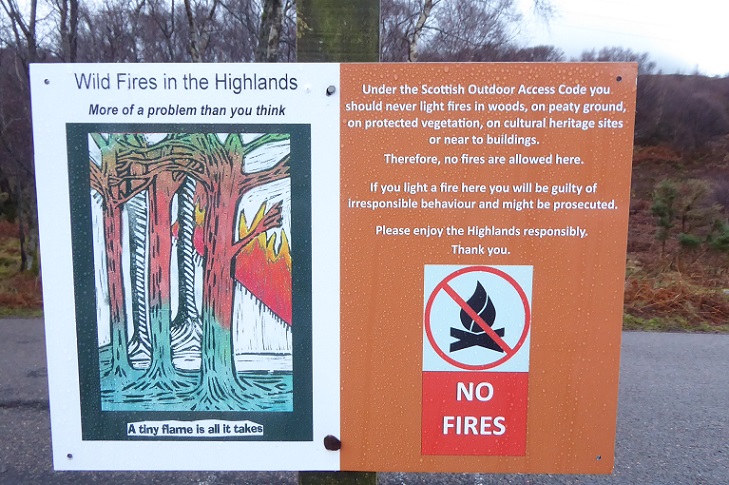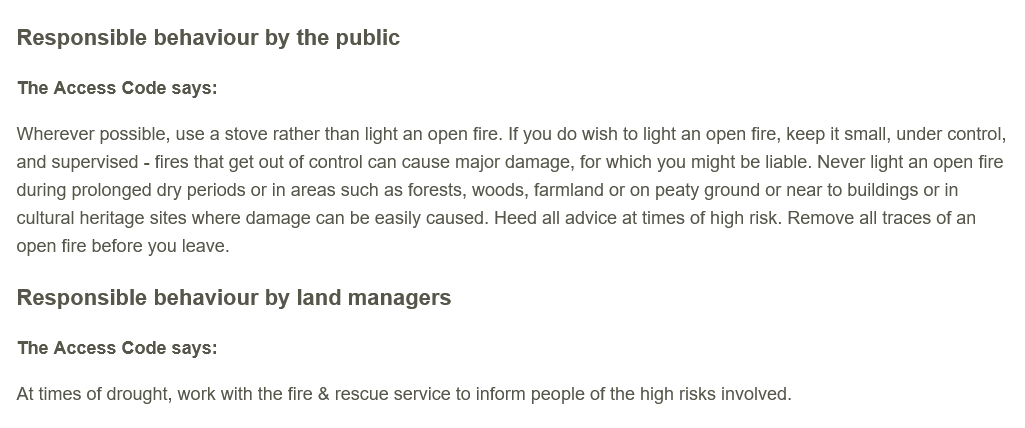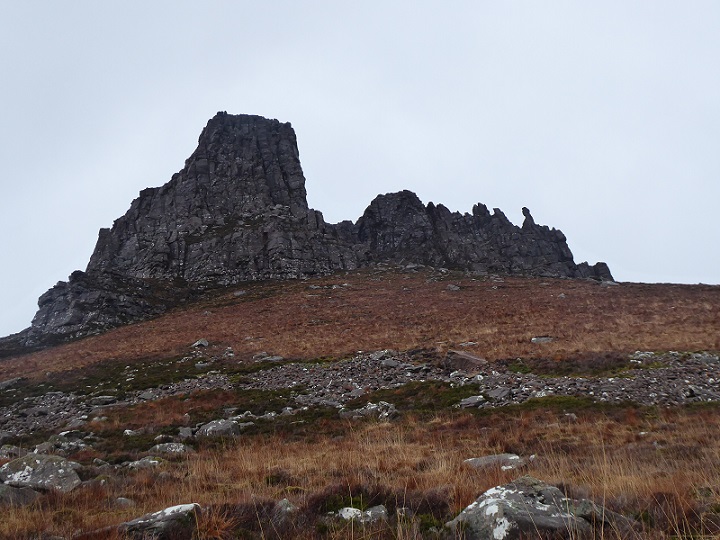
[NB My apologies, I have corrected an error in the first version of this post and have used Assynt in the title, which I cannot change without destroying weblinks, when it should have said Coigach – see comment below]
While staying near Ullapool last week I came across this sign, which was new to me, on a couple of occasions. The first was on the track to Benmore Lodge near Glen Oykel and the second at Stac Pollaidh in Assynt. There was no information on any of these signs I saw to say who had erected them.
My first thought was that they might be an initiative associated with the North Coast 500. However, on checking the official NC500 website their page on “Leave no trace” (see here) says nothing about fires, so possibly the signs are a landowner initiative. Whoever is responsible, the wording goes a step further than any other sign I have seen in undermining the access rights that were introduced by the Land Reform (Scotland) Act 2003. The law, as stated by NatureScot the public agency responsible for access rights, is very clear (see here):
“The lighting of a fire is allowed as part of the exercise of access rights, if it is done responsibly”.
The reasons why this sign is unlawful
What the Scottish Outdoor Access Code (SOAC), a document that was formally approved by the Scottish Parliament on 1st July 2004, says about fires is included the section on camping) (see here):
 The key message is if people want to light an open fire they should keep it small, under control and supervised.
The key message is if people want to light an open fire they should keep it small, under control and supervised.
The first thing that is wrong in advice on the sign is the sentence starting “Never light an open fire…………..”. This is qualified in SOAC by some key words which are omitted from the sign “where damage can be easily caused”. This is important because what constitutes a wood or peaty ground is not straightforward: there are glades in forest areas where it might be safe to light a small fire 90% of the time; it is the same within areas within what is otherwise generally peaty ground, for example on rocks or by stony loch shores.
The SOAC advice is based on commonsense as well as science: for much of the year peaty ground is far too wet too burn. The major risk is during dry periods when a cigarette tossed out of a car window can set an entire hillside alight.
Secondly, it is false logic to use the advice that fires shouldn’t be lit in certain places to asserting that fires should not be lit anywhere – “no fires are allowed here”. From the Stac Pollaidh sign it was easy enough to spot places along the shore of Loch Lurgainn below which were not covered by any of places listed.
Thirdly, if all of this wasn’t bad enough, the next statement “If you light a fire here you will be guilty of irresponsible behaviour and might be prosecuted” is outrageous. SOAC sets out what should be regarded as responsible behaviour, both by people exercising their rights of access and those responsible for managing it. Where a visitor breaches SOAC, they lose their rights to be on land as set out in the Land Reform Act, but this is a civil matter. To suggest that anyone who does not stick to the advice issued under SOAC is guilty of anything, or that they might be prosecuted for doing so, is wrong. The criminal law is a separate matter.
This distinction, between what SOAC says and the criminal law says about fires, and the different remedies for both are clearly set out in NatureScot’s guidance on fires issued in 2007 (see here). The wording on the sign appears a deliberate attempt to conflate the two and by doing so intimidate the public from exercising their access rights. As a result, in my view the wording on sign is clearly unlawful and I will be contacting the Highland Council Access Team to request they all the signs are removed.
Signs such as this are counter-productive. By mis-representing what SOAC says, the people responsible for the sign risk undermining it and other landowners who are doing the right thing and whose advice is focussed on the risks posed by fires during prolonged dry periods. It also undermines Scottish Fire and Rescue’s endorsement of SOAC (see here):
“Anyone holidaying or going to the countryside for sports or leisure can find some great advice about staying safe by reading the Scottish Outdoor Access Code.”
But what about the risk of fires to conservation?
A significant number of people working working for conservation organisations now appear opposed to visitors to the countryside ever lighting fires. The argument is that given the climate and nature conservation emergencies, we cannot no longer afford to allow fires in the countryside. To which my response is that we would achieve far more if conservationists focussed their efforts on land-management rather than trying to change access rights.
The land round Stac Pollaidh used to be part of the Inverpolly National Nature Reserve until it was declassified because it was not being managed for nature. It still is a Site of Special Scientific Interest designated for its blanket bog (see here) – a protected area in terms of the wording on the sign. The SSSI has been classified as being in unfavourable condition for years but the reason for this is not fire – the land is far too wet most of the time – but the high numbers of deer. These were only too evident on our walk up Stac Pollaidh:

Scrub woodland has developed immediately alongside the road beneath Stac Pollaidh but the reason the steep slopes above it – which are relatively well drained and in places would naturally develop into woodland not bog – are totally devoid of trees comes down to the number of deer grazing it.

The day after I photographed the sign at the Stac Pollaidh car park, my partner and I drove back to Glasgow. Coming over the Slochd, just after the sign that marks the boundary of the Cairngorms National Park, a wall of flame was jumping up the north side of the road – unfortunately, there was no safe place to stop and take photos. The landowner was taking advantage of the dry weather and lack of snow to do a bit of muirburn.
While there is an ever-increasing clampdown on members of the public lighting fires on peaty soils, on the grounds that this is bad for the environment, landowning interests – as I showed in my last post (see here) – have been trying to argue that muirburn is good for climate change and good for the environment. Both cannot be right but the science is generally against grouse moor interests. The fact is that deliberate muirburn by land-managers does considerably more damage to the natural environment than accidental fires lit by the public. Conservation organisations, including our National Parks, should be calling out the hypocrisy.
Instead of challenging grouse moor interests, however, organisations that should know better either remain silent or are actively promoting this two-faced contradictory approach. The National Trust for Scotland, for example, was warning visitors to the Mar Lodge Estate about the risks of fire for years before it took the decision to stop muirburn. Its national leadership still remains silent about all muirburn carried out by neighbouring landowners – but then their patron is Prince Charles one of the worst “offenders” (see here) in the Cairngorms National Park. (Incidentally, just like lighting a fire under access rights, muirburn is not normally a criminal offence).
The Cairngorms National Park Authority’s (CNPA) draft National Park Partnership Plan contained some proposals to reduce muirburn (see here) but these are generally weak being aimed at protecting peat more than 50cms deep, as per current Scottish Government policy. The problem is that you’d be lucky to find peat that deep on grouse moors that are burned regularly. Effectively, the CNPA message to landowners is that they intend to do very little to reduce the damaging impacts of muirburn, despite the climate and nature emergencies.
However, when it comes to fires lit by the public the CNPA, which has a statutory duty to protect access rights, is proposing a very different approach (see here): 
Here we have an access authority proposing to adopt a policy which is totally contrary to the SOAC.
In my view this is even more outrageous than the messages on the “No Fires” signs in the North West and risks undermining those access authorities, such as Highland Council, which are still trying to uphold access rights.
The only explanation I can think of for the hypocrisy of the CNPA in taking one approach to fires by landowners and another by the public is that they are under the thumb of landowning interests. The organisations that represent outdoor recreation should write to NatureScot and Lorna Slater, the Green Minister responsible for National Parks, demanding that they intervene.

When you Contact Highland Council Access Team to request these signs are removed you may wish to challenge Matt Dent over their own deliberate and acknowledged strategy of leaving No Fires or No Camping signs in situ for the entire tourist season in a blatent attempt to discourage legal access rights
I sent you correspondance regarding this policy in Sept 2021
Please make contact if you wish further info
My apologies Garry, I was away a fair bit when you sent your emails and I managed to miss them. The letter you have been sent from Highland Council deserves a separate post and I will contact you directly about that, Nick
I have mixed feelings about this one Nick.
I agree that the best advice is that in SOAC, and there is a tendency for some land managers to go far beyond the SOAC rules.
On the other hand, there are an awful lot of fire-loving folks who are not very good at following the SOAC. I occasionally have a fire when camping but only in pretty limited circumstances – on waterside shingle below the high water mark/ flood level, using driftwood or wood I brought myself, when you can devote some time in the morning for leave-no-trace efforts. A collapsible firebox makes this easier. There are other folks doing the same but it’s hard to know as by definition they leave no trace.
What we do see is a lot of ugly fire scars and in inappropriate places like ancient pinewood. On Loch Earn there have been fires built against living trees, and in Glen Etive I’ve seen very large fire scars, well over a meter across. When you see this you have some sympathy with the land managers. Perhaps if SOAC specified a maximum size of 30cm, specified the harms of removing dead wood, and mentioned appropriate places for a fire such as waterside shingle this would help. Perhaps the SOAC advice assumes a level of public knowledge that isn’t there?
Hi Pete, I am not a great fan of fires either – though I was with a group in May in the Lakes who had one quite safely in a glade in a oak wood in the summer (with the wood supplied by the farm that operated the campsite). But your point about “very large scars 1 meter across” illustrates my point: why are we so concerned about small burnt patches when entire hillsides are being scarred by the grouse moor industry? Are those scars not even uglier? Why do outdoor recreationists, conservationists and public authorities not see this and instead choose to criticise fellow outdoor recreationists? Which scars look worse from outer space (google earth) – those along the shores of Loch Earn, caused by dozens of people, or those on Prince Charles’s estate at Delnadamph, which have basically being caused on the orders of one person? Nick
I think the tide is at long last beginning to turn against muirburn (and against other deleterious aspects of intensive grouse moor management such as hill tracks and raptor persecution) and not before time. Besides carbon release, loss of wildness and flood risk, some wildfires start off as controlled muirburn.
Andrew Painting’s excellent book has quite a bit about this, and also about campfires.
I do sometimes wonder about driven grouse shooting. It is a fairly recent development and when first introduced in the mid 19th century there were letters in the sporting press from shooters denouncing it as unsporting.
Walked-up grouse shooting, with non-intensive management and resulting lower grouse densities is practiced in most countries that have willow grouse. I would regard that pursuit as environmentally benign. Indeed I have done it myself, walking several miles and shooting one grouse in a day.
Firstly, Stac Pollaidh is not in Assynt – it’s in Coigach CC area which is in the parish of Lochbroom. Inverpolly is also designated for its birch woods. I think the signs are a landowner initiative. Living in Assynt and on the border of Coigach I have mixed feelings here. Over the years we have had some really bad fires and all have been started by carelessness on the part of fishermen, kayakers, campers etc. On one occasion the fire brigade told us to pack our valuables and be ready to leave but fortunately the wind changed direction. The damage to the peat and regenerating trees has been severe and heart rending. We put notices up on the gate to our common grazings when there was a prolonged drought telling people to take great care – I favour putting warnings out when there is a higher risk rather than have notices out permanently. However, I think we also need firebreaks – which would be expensive.
Yes, the hills and moors in Coigach have been burned over the centuries, but increasing in frequency with the introduction of large sheep farms. The vegetation, mainly purple moor grass and deer sedge has been burned regularly to provide a sweet early bite for the sheep stock. I have seen both sides of Stac Pollaidh subjected to huge uncontrolled fires and the flowe ground between Loch Sionascaig and the River Kirkaig burnt to a crisp, despite its protected status.
There are other environmental vandals out there besides grouse moor keepers and careless campers.